Abby Road NEON (ABBY) Soil Descriptions
Distributed Soils Reports
Pedon Descriptions
Pit‐level observations and field measurements reported using the standard NRCS format. They contain volume estimates for coarse fragments > 20 mm where applicable.
Site Level Plot Summary
A narrative summary that places the sampled soil pedons in the broader context of soils and geomorphology for the entire NEON site.
Megapit Images
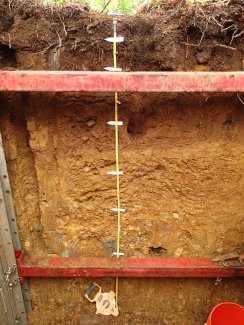
D16 ABBY megapit soil profile 0-200 cm
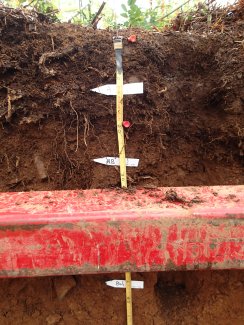
D16 ABBY megapit soil profile 0-68 cm
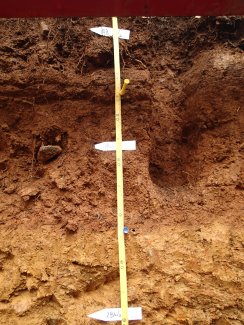
D16 ABBY megapit soil profile 25-90 cm
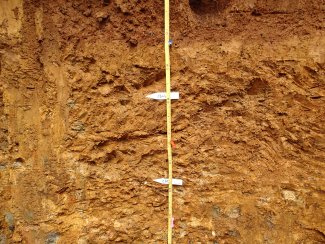
D16 ABBY megapit soil profile 63-139 cm
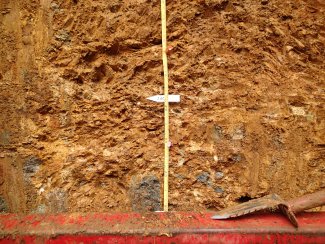
D16 ABBY megapit soil profile 90-151 cm
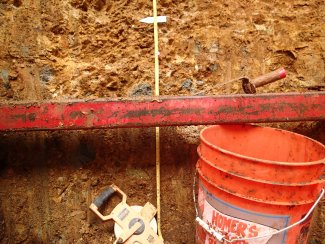
D16 ABBY megapit soil profile 111-195 cm
Megapit Pedon Description
| Print Date | Feb 18 2016 |
|---|---|
| Description Date | Jun 2 2015 |
| Describer | D. Ufnar/E. Dahlke |
| Site ID | 2015WA011001 |
| Pedon ID | S2015WA011001 |
| Lab Source ID | KSSL |
| Lab Pedon # | 15N0680 |
| Soil Name as Described/Sampled | Kinney |
| Classification | Fine-loamy, isotic, mesic Andic Humudepts |
| Pedon Type | confirmation description |
| Pedon Purpose | research site |
| Taxon Kind | series |
| Geomorphic Setting | on crest of glacial hill |
| Upslope Shape | convex |
| Cross Slope Shape | convex |
| Particle Size Control Section | 25 to 100 cm. |
| Description origin | NASIS |
| State | Washington |
| County | Clark |
| MLRA | 3 -- Olympic and Cascade Mountains |
| Soil Survey Area | WA011 -- Clark County, Washington |
| Std Latitude | 45.7623840 |
| Std Longitude | -122.3296860 |
| Parent Material | volcanic ash and/or colluvium over alpine glacial drift |
| Description database | KSSL |
| Diagnostic Features | umbric epipedon 3 to 44 cm. andic soil properties 3 to 74 cm. cambic horizon 44 to 200 cm. |
| Slope (%) | 3.0 |
| Elevation (meters) | 369.0 |
| Aspect (deg) | 180 |
| Drainage Class | moderately well |
| Horizon Details |
Oi--0 to 3 centimeters (0.0 to 1.2 inches); slightly decomposed plant material; abrupt smooth boundary. Lab sample # 15N03474 A--3 to 19 centimeters (1.2 to 7.5 inches); very dark brown (7.5YR 2.5/2) broken face medial loam, dark brown (7.5YR 3/3) broken face, dry; 12 percent clay; strong fine granular structure; soft, friable, slightly sticky, slightly plastic; weakly smeary; many very fine roots between peds and common medium roots throughout and many fine roots between peds and common coarse roots throughout; common fine irregular pores; clear smooth boundary. Lab sample # 15N03475 AB--19 to 44 centimeters (7.5 to 17.3 inches); dark brown (7.5YR 3/2) broken face medial silt loam, brown (7.5YR 4/4) broken face, dry; 19 percent clay; moderate fine subangular blocky structure; soft, friable, slightly sticky, moderately plastic; weakly smeary; many very fine roots between peds and common medium roots throughout and many fine roots between peds and few coarse roots throughout; common very fine irregular and few medium tubular and common fine irregular pores; 10 percent nonflat subangular indurated 2 to 75-millimeter basalt fragments; clear wavy boundary. Lab sample # 15N03476 Bw1--44 to 74 centimeters (17.3 to 29.1 inches); brown (7.5YR 4/4) broken face medial silt loam, strong brown (7.5YR 5/6) broken face, dry; 21 percent clay; strong fine subangular blocky structure; soft, friable, slightly sticky, moderately plastic; weakly smeary; common very fine roots between peds and many medium roots between peds and common fine roots between peds; common very fine tubular and common fine irregular pores; 10 percent nonflat subangular indurated 2 to 75-millimeter basalt fragments; abrupt smooth boundary. Lab sample # 15N03477 2Bw2--74 to 103 centimeters (29.1 to 40.6 inches); 68 percent brown (7.5YR 5/4) broken face and 15 percent strong brown (7.5YR 4/6) broken face and 15 percent yellowish red (5YR 4/6) broken face and 2 percent black (10YR 2/1) broken face silt loam, 68 percent strong brown (7.5YR 5/6) broken face and 15 percent yellowish red (5YR 5/6) broken face and 15 percent strong brown (7.5YR 5/8) broken face and 2 percent dark brown (10YR 3/3) broken face, dry; 25 percent clay; moderate fine subangular blocky structure; slightly hard, firm, slightly sticky, moderately plastic; nonsmeary; few very fine roots between peds; few fine irregular and common fine tubular pores; 10 percent nonflat rounded moderately cemented 2 to 75-millimeter mixed rock fragments; clear smooth boundary. Lab sample # 15N03478 2BC--103 to 131 centimeters (40.6 to 51.6 inches); 36 percent brown (7.5YR 5/4) broken face and 30 percent strong brown (7.5YR 4/6) broken face and 30 percent yellowish red (5YR 4/6) broken face and 2 percent black (10YR 2/1) broken face and 2 percent pinkish gray (7.5YR 6/2) broken face paragravelly silty clay loam, 36 percent strong brown (7.5YR 5/6) broken face and 30 percent yellowish red (5YR 5/6) broken face and 30 percent strong brown (7.5YR 5/8) broken face and 2 percent dark brown (10YR 3/3) broken face and 2 percent pink (7.5YR 8/3) broken face, dry; 31 percent clay; moderate fine subangular blocky structure; slightly hard, firm, slightly sticky, moderately plastic; nonsmeary; few very fine roots between peds; 20 percent nonflat rounded weakly cemented 2 to 75-millimeter mixed rock fragments; clear smooth boundary. Lab sample # 15N03479 2C--131 to 200 centimeters (51.6 to 78.7 inches); 36 percent brown (7.5YR 5/4) broken face and 30 percent strong brown (7.5YR 4/6) broken face and 30 percent yellowish red (5YR 4/6) broken face and 2 percent black (10YR 2/1) broken face and 2 percent pinkish gray (7.5YR 6/2) broken face very paragravelly silt loam, 36 percent strong brown (7.5YR 5/6) broken face and 30 percent yellowish red (5YR 5/6) broken face and 30 percent strong brown (7.5YR 5/8) broken face and 2 percent dark brown (10YR 3/3) broken face and 2 percent pink (7.5YR 8/3) broken face, dry; 25 percent clay; structureless massive; slightly hard, firm, slightly sticky, moderately plastic; nonsmeary; 40 percent nonflat rounded very weakly cemented 2 to 75-millimeter mixed rock fragments. Lab sample # 15N03480 |
Credits: This megapit soil pedon description was generously created by USDA Natural Resource Conservation Service staff, with particular thanks to Larry West, Jon Hempel, and numerous field staff.